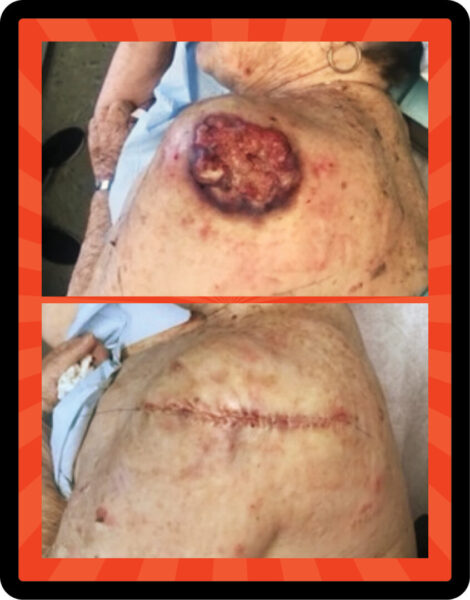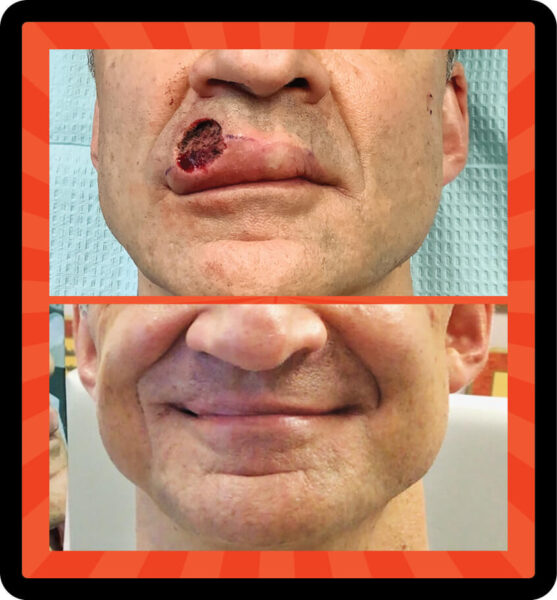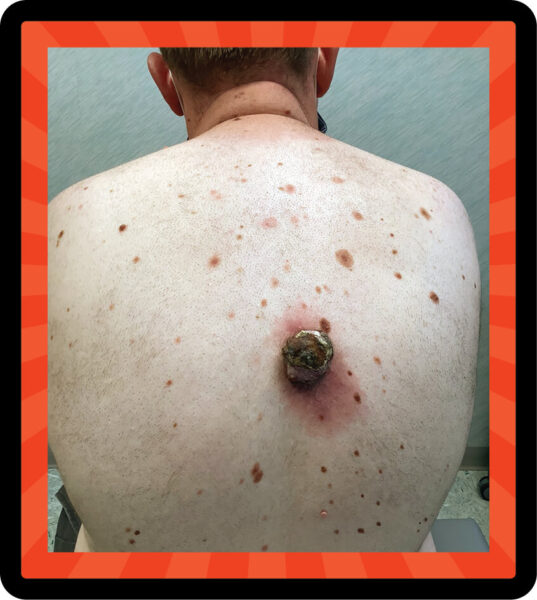BowTied Thinker/Adobe Stock
… because too many people still think skin cancer is “no big deal,” maybe we want to scare you a bit. Despite recent advances in detection and treatment, skin cancer is a serious disease that can have devastating consequences. Read our six important lessons and, yes, be a little afraid. It might make all the difference.
Skin cancer develops over time, often over decades, mainly caused by accumulated damage from exposure to ultraviolet (UV) radiation from the sun or from indoor tanning. Despite increased awareness, all three of the main types of skin cancer are on the rise, and we want you to take them seriously. The most common types are basal cell carcinoma (BCC), squamous cell carcinoma (SCC) and melanoma. It’s hard to pinpoint an exact number of cases, because only melanoma (the least common but most dangerous of the three) has official registries in the U.S. Using the best research available, The Skin Cancer Foundation estimates about 3.6 million BCCs a year in the U.S., about 1.8 million SCCs and about 200,000 melanomas. That’s a lot of skin cancer!
Paradoxically, however, public awareness successes and medical breakthroughs have had an unintended consequence: They have led too many people to conclude that skin cancer is no big deal, that it is a relatively simple medical matter that involves detection, treatment that is only mildly invasive, no recurrence or complications, done.
Today, thankfully, most skin cancer cases are straightforward. But you also need to understand that for a constellation of reasons, many skin cancers do not follow this tidy, predictable script. Yes, a tiny percentage of skin cancers result in death. But many, many more may become messy, complicated, disfiguring and disruptive in unanticipated ways. Hence the Foundation’s hashtag: #SkinCancerIsSerious.
We tapped two top experts, who share crucial lessons from a few of the not-so-tidy cases they’ve treated: Deborah S. Sarnoff, MD, is a clinical professor in the Ronald O. Perelman Department of Dermatology at NYU Grossman School of Medicine. She is also codirector of Cosmetique Dermatology, Laser & Plastic Surgery LLP in New York City and Long Island, and president of The Skin Cancer Foundation. Matthew Mahlberg, MD, is director of the Colorado Center for Dermatology & Skin Cancer in Denver. Both physicians are fellowship-trained Mohs surgeons.
Lesson 1: “Ignore it and it will go away” is not a viable option.
Dermatologists often see patients who have let a new or persistent bump or spot on their skin go unchecked because “it’s only a pimple,” or “I’ve always had lots of moles — what’s one more?” This reluctance to consult a medical professional about what a patient almost certainly knows is a classic warning sign of skin cancer can have many sources, Dr. Sarnoff notes. Sometimes it’s as simple as fear of having one’s worst suspicions confirmed. “Never underestimate the power of denial,” she says. “I see it all the time. A younger person who has always been healthy, for instance, can’t imagine that something so small could be a serious problem. So the fear that it might be gets tucked away in the denial compartment of the brain.”
People may also drag their feet in consulting a doctor because of their anxiety about the physical pain that could accompany diagnosis and treatment. Body shame is another deterrent. “A patient might put off coming in because the spot is in an embarrassing place, like the groin. And I’ll never stop being shocked by female patients who say, ‘I hate having a dermatologist see all my cellulite and extra flab,’” she says. “Trust me, we aren’t looking at that. When dermatologists check for skin cancers, we’re like hounds sniffing for truffles in a forest. We’re focused on the thing that matters.” Besides, she adds, “good dermatologists always provide a gown that patients can strategically adjust to allow modesty as we check each area.”
Dr. Sarnoff vividly recalls one of her patients, an elderly widow who lived alone, whose adult children decided it was time to move their mother to an assisted living facility. The facility required a thorough physical before a new patient could be admitted. “This woman’s children had not seen their mother undressed in years, so when the doctor was examining her, they were horrified to see this enormous open wound on her shoulder and back,” Dr. Sarnoff says. “Through a decade of weddings and holidays and all sorts of other activities, their mother covered this thing with her clothing, and all the while it kept getting bigger and bigger. And she never confided in a single one of her five children. She knew it was there, but she was in denial. She figured it hadn’t killed her in the 10 years she’d had it, so why rock the boat?”
The lesion turned out to be a large SCC, the second most common type of skin cancer. The tumor required extensive surgery followed by radiation. But this patient was extremely lucky: Her cancer was eliminated, and she has remained healthy.

Didn’t Want to Rock the Boat: Elderly patients often do well with treatment but should not delay. By the time Dr. Sarnoff saw the lesion, top, she says it was large, oozing and raised “like a mushroom.” She removed the SCC tumor, and her partner, Robert H. Gotkin, MD, expertly closed the wound.
For the record, Dr. Sarnoff strongly advocates robust treatment for elderly people with skin cancer. “Often, the families of, say, a 90-year-old with skin cancer think the situation is not dire enough to warrant putting their parent through the ‘ordeal’ of treatment, so they’ll opt out. But the treatment is usually not that onerous, and it can make a huge difference in a person’s quality of life,” she says. “Five years later, the kids will be back with that same parent, who’s now 95. His skin cancer has spread, is making him miserable, and can no longer be safely treated. I’m a big believer in treating when and if you can. And in our practice, that has even meant doing Mohs surgery on people over 100!”
Lesson 2: A misdiagnosis can throw a roadblock in the path of speedy, effective treatment.
It is unfortunate, but not uncommon, for a misdiagnosis to delay the treatment of skin cancer. A recent patient of Dr. Sarnoff’s had symptoms of flaking, itching and redness on her scalp — all typical of noncancerous inflammatory skin conditions. The first dermatologist the patient consulted diagnosed psoriasis of the scalp and prescribed a steroid lotion. When the lotion brought no improvement, the patient sought a second opinion from a different dermatologist, who believed the symptoms to be a fungus and prescribed an antifungal medication. After using that medication for a few months with no relief, the patient came to Dr. Sarnoff. “I told her, ‘Those diagnoses make sense, but since neither treatment has worked, we need to do a small biopsy,’” Dr. Sarnoff remembers.
The biopsy revealed that the patient had a superficial basal cell carcinoma. But this one, as Dr. Sarnoff puts it, “extended outward on her scalp like a yarmulke.” The patient was an attractive woman in her 40s, and fortunately, her cancer was not advanced. So Dr. Sarnoff decided to forego Mohs surgery, which would have entailed a skin graft on the top of the patient’s head (in essence, a large bald spot that would have necessitated her wearing a wig or hairpieces), in favor of fluorouracil (aka 5-FU), a topical agent.
If the topical treatment failed to work, Dr. Sarnoff reasoned, she could proceed to surgery. “It seemed cruel to sentence this woman to being bald the rest of her life if there was an alternative. After treatment, we rebiopsied, and the good news is that there were no more cancer cells,” she says. The 5-FU had killed them all. The bad news is that the patient did end up without hair in several areas, most likely because the skin cancer itself scarred her follicles. “Or, maybe the topical treatment penetrated deeply enough to damage some of the follicles, though that would be rare,” Dr. Sarnoff says. Happily, the patient has been able to use the surrounding hair to comb over and mask the bald spot.
Lesson 3: Personal risk factors raise the odds — and you need to be hyper-aware of yours.

Scary Defect, Good Outcome: One of the hazards of letting an unusual lesion go unchecked is that it can grow beneath the surface. Dr. Sarnoff performed Mohs surgery to remove a BCC on the right side of this man’s upper lip. Luckily, Dr. Gotkin reconstructed the “cosmetically sensitive area,” with excellent results, above.
A bottom-line fact of life is that skin cancer is more likely to turn up in certain people than in others. Individuals at greater risk include those who have a family history of the disease, suggesting a genetic predisposition; who have already experienced one or more bouts of skin cancer; who have light-colored skin that burns or freckles easily, blue or green eyes, and blond or reddish hair; who are immunocompromised via a chronic medical condition or a medication they take regularly; who have been treated with radiation for a previous medical issue; who had five or more sunburns in childhood; who are elderly, particularly elderly and male; and who have spent time in indoor tanning booths. (This last risk factor remains stubbornly common, despite decades of warnings and articles about the hazards of such facilities.)
Anyone with one or more of these risk factors needs to be keenly attuned to any changes in the appearance or feel of their skin. Occasionally, though, even the most vigilant person can lapse in this careful monitoring. One of Dr. Sarnoff’s longtime patients, a man in his 40s, was born with a condition called nevoid basal cell carcinoma syndrome (NBCCS), also known as Gorlin syndrome — a kind of genetic glitch that is characterized by multiple BCCs. Accustomed to being constantly on the lookout for new or changing spots, even this man was thrown slightly off-course by the COVID-19 pandemic and the out-of-the-ordinary way his disorder manifested during that time. A new bump turned up on his upper lip, a place where he had never had a BCC or even a benign cyst. As expert as he had become at determining which spots were serious and which were not, he somehow dismissed this one as inconsequential and didn’t seek professional advice. And because of the lockdown, he was not seeing Dr. Sarnoff, his dermatologist, for his usual frequent checkups.
By the time this newest BCC was diagnosed, it was deep enough to require several successive stages of Mohs surgery. The after-effect was that the area all around the lower part of the patient’s face looked distorted and disfigured. “It was not a pretty sight,” concedes Dr. Sarnoff. “And he’s a handsome guy.” The reconstruction was done by Robert Gotkin, MD, Dr. Sarnoff’s plastic surgeon partner (and husband). As is common with skin cancers, this reconstruction, aimed at attaining the best cosmetic result with minimal scarring, encompassed a large geographic portion of the patient’s face. “It was a great success,” Dr. Sarnoff says. “The surgery eliminated the cancer, and my husband did a beautiful reconstruction. The patient ended up looking terrific.”
Lesson 4: External risk factors can raise the odds, too.
Unlike personal risk factors, these relate to the outward conditions of your life: where you reside, your recreational choices, the work you do. Although you need sun protection in virtually every environment, certain locales and situations unquestionably put you at greater risk. Airline pilots and military personnel, for example, are regularly exposed to conditions that increase their risk of skin cancer. And in Colorado, where Dr. Mahlberg practices in his mile-high hometown of Denver, the residents’ enthusiasm for the outdoors is often etched on their faces.
“We’re all weekend warriors, including me,” he says. “One of my favorite summer pastimes is hiking the state’s 54 14,000-foot peaks. Summiting a ‘14er’ and looking out at the majestic Rockies is a thrill like no other. I’ve hiked these peaks my whole life, and I love it, and now my kids love it, too.” The problem? At that altitude, the UV radiation is roughly twice as powerful as it is at sea level. Citing statistics compiled by the World Health Organization (WHO) and the Environmental Protection Agency (EPA), Dr. Mahlberg notes that for every 1,000 feet you go above sea level, you get an extra 3 to 5 percent of UV radiation. So even in downtown Denver, a person is exposed to roughly 20 percent more radiation than at sea level. At 14,000 feet, it’s around 50 percent. According to a study on sunburn, the time it takes someone to get sunburned at a typical 10,000-foot-high ski resort can be as little as six minutes.
Dr. Mahlberg emphasizes that at high altitude environments, sun protection is incredibly important, but dermatologists cannot just “tell people to stay indoors under your bedsheets and be scared of the sun. They won’t listen.” Nonetheless, the region’s sunny weather and high altitudes are reflected in the nature of his medical practice. “The conditions here contribute to an earlier age of skin cancer onset, as well as an increased quantity of skin cancers over patients’ lifetimes. So some of the patients we see have an overwhelming skin cancer burden.” (These patients, he stresses, not only need to double down on all the usual sun protections — vigilant use of sunscreen, protective clothing, avoidance of direct sunlight — but also, to see their dermatologist every three to six months for “ongoing surveillance.”)
One family of patients that Dr. Mahlberg treats has borne this burden over generations. “They’ve all grown up in the foothills and mountains here, above 9,000 feet, and had a ton of exposure because they love to hike and spend time outdoors. And they’ve all inherited the family’s characteristic fair skin. So as they’ve moved into their 60s and 70s, a couple of family members have had a tremendous burden of squamous cell carcinomas — dozens and dozens of them. The result can be what my colleague, dermatologist Jerome Shupack, MD, and I have dubbed ‘terminal skin,’ so worn out from multiple skin cancers and surgeries that further surgical interventions become almost impossible.” This family also has an additional risk factor, the magnitude of which, Dr. Mahlberg believes, needs to be more widely understood: They share an inherited rheumatologic condition that requires immunosuppressive medications, which themselves significantly raise the risk for skin cancers. One member of the family, who’d been treated for more than 100 SCCs, recently died, unable to keep fighting the cumulative effects of all that sun exposure, as well as some of the other factors mentioned.
Lesson 5: The bathwater can divert your focus from the baby — and you can pay dearly for that, when it is melanoma.

Convinced Himself It Wasn’t Serious: The COVID lockdown and maybe some magical thinking convinced this man his cancerous tumor was only a boil. But it kept growing and was elevated, clear signs of risk. It was actually melanoma, and, by the time he was referred to Dr. Sarnoff, it had become invasive, requiring more extensive treatment.
As improbable as it may seem, sometimes people will overlook — whether because they’re in various forms of denial or because they genuinely don’t perceive the severity of the problem — a lesion that, effectively, is screaming for medical attention. For months, they may focus less on the sore itself than on a pesky side effect produced by the sore and thereby lose a crucial window for early detection and treatment of a gravely serious skin cancer.
Dr. Sarnoff recently handled one such highly dramatic and tragic case when a patient came into her office with an enormous bandage covering the middle of his back. The “boil” beneath the bandage, the man explained, had been oozing and bleeding for months, regularly staining the sheets on the bed he shared with his wife, who was irritated at the mess. He assumed the boil or cyst was simply slow to heal, and rather than going to a dermatologist to have it checked out (a mistake partially attributable to the COVID lockdown then in place), the man got creative and devised a way to bandage the lesion in such an efficient way that it was completely covered, and no blood or pus oozed out while he slept. Immediate problem solved.
Meanwhile, though, the “boil” kept growing. And bleeding. And hurting. And the man, the father of a 7-year-old, gritted his teeth and kept bandaging it to spare the sheets and, presumably, the scrutiny of his wife. (She, too, thought it was only a boil or harmless cyst.)
Finally, he made an appointment with a dermatologist, who also believed the extremely raised lesion was a benign cyst that needed to be removed by a surgeon. That doctor immediately referred the patient to Dr. Sarnoff, whose biopsy and other tests revealed a melanoma so large and so deep that it had already spread to the man’s liver and his brain. He is currently on an immunotherapy regimen that does not appear to be working, as is true for approximately 50 percent of people with metastatic melanoma who are prescribed this treatment.
Lesson 6: Dr. Google is not a trustworthy source of medical guidance.
Anyone with even a nodding acquaintance with the vast wilderness that is the Internet knows that a simple Google search about any ailment can instantly produce a medical textbook’s worth of contradictory and largely suspect “data.” One word: Resist. Dr. Sarnoff notes that her husband and business partner, Dr. Gotkin, keeps a mug on his desk (a gift from a patient) that says, “Please don’t confuse my MD degree with your Google search.” It’s sound advice that, in extreme scenarios, could end up saving your life.
“We’ve been dealing with these purported cures for skin cancer, like Black Salve, for decades,” Dr. Mahlberg says, “but with the Internet, they’ve just exploded.” In 2012, when the state of Colorado, along with Washington state, became the nation’s first to legalize recreational marijuana, he recalls, “Almost overnight, marijuana cures popped up all over the Internet. There were all these new topical remedies you could allegedly apply to skin cancer and magically make it disappear. And people would try them, particularly young people. If you’re 32 years old and have had a big skin cancer on your nose, you’ll do almost anything to avoid a surgery.”
One of these desperate young people found his way to Dr. Mahlberg several years ago. At 32, the patient had a large BCC on his nose that, he reported, had been growing for two or three years. When asked why he had waited so long to see a physician, the young man said that he had been treating the cancer with cannabis oil, a cure that thousands of Internet users swore by. And it had seemed to work for a while: The cancer had disappeared from the surface of his face for some time. “In fact,” Dr. Mahlberg says, “cannabis oil does have some anti-inflammatory properties, and like any moisturizing agent will often make certain types of skin cancers look better. They may appear a bit less red; they might smooth out a little. So people will keep treating the cancer this way for two or three years, but it is still there, growing beneath the surface of the skin.”
In this patient’s case, the surface of his skin looked pretty good, and Dr. Mahlberg was initially optimistic that there wasn’t much to find underneath it. “In actuality,” he says, “the cancer had tremendous subclinical extent beyond what could be seen with the eyes.” The patient underwent Mohs surgery and had to have a complicated reconstruction that would have been unnecessary had he not lost two or three years pursuing an ersatz cure.
Dr. Mahlberg believes the best way to treat a BCC is nearly always with surgery. “It has the highest cure rate and even has fewer side effects and downtime compared to other therapies that are offered,” he says. “And it won’t sweep the cancer under the rug, only to have it rear its ugly head later on.”
“Even if a Mohs surgery is complicated and a lot of tissue has to be sacrificed to remove all the cancerous cells,” Dr. Sarnoff explains, “with skilled reconstruction by a Mohs or plastic surgeon, the cosmetic results can be excellent!”
ABOUT THE AUTHOR:
Lorraine Glennon is a Brooklyn-based writer and editor. Her articles about skin cancer for this Journal have scared her into hypervigilance when it comes to sun protection.





